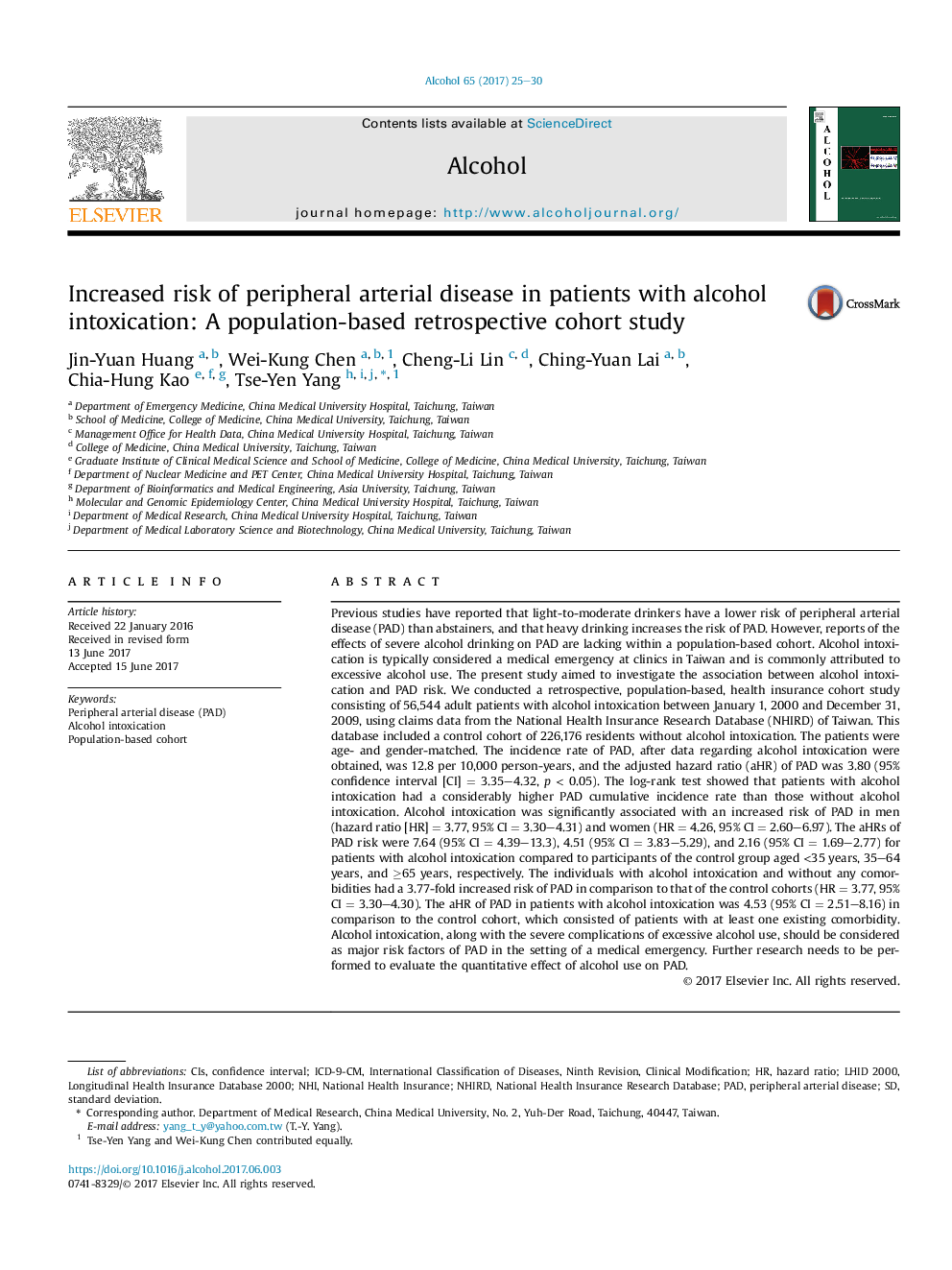| کد مقاله | کد نشریه | سال انتشار | مقاله انگلیسی | نسخه تمام متن |
|---|---|---|---|---|
| 5119548 | 1485964 | 2017 | 6 صفحه PDF | دانلود رایگان |
- The purpose of the study was to investigate whether a link exists between PAD risk and alcohol intoxication.
- Alcohol intoxication-related PAD incidence rate was 12.8 per 10,000 person-years.
- Alcohol intoxication-related adjusted risk for PAD was 3.8-fold greater than for matched controls.
- Excessive alcohol use might be a pivotal risk factor for PAD.
- An important public health policy should be the avoidance of excessive alcohol use to prevent PAD.
Previous studies have reported that light-to-moderate drinkers have a lower risk of peripheral arterial disease (PAD) than abstainers, and that heavy drinking increases the risk of PAD. However, reports of the effects of severe alcohol drinking on PAD are lacking within a population-based cohort. Alcohol intoxication is typically considered a medical emergency at clinics in Taiwan and is commonly attributed to excessive alcohol use. The present study aimed to investigate the association between alcohol intoxication and PAD risk. We conducted a retrospective, population-based, health insurance cohort study consisting of 56,544 adult patients with alcohol intoxication between January 1, 2000 and December 31, 2009, using claims data from the National Health Insurance Research Database (NHIRD) of Taiwan. This database included a control cohort of 226,176 residents without alcohol intoxication. The patients were age- and gender-matched. The incidence rate of PAD, after data regarding alcohol intoxication were obtained, was 12.8 per 10,000 person-years, and the adjusted hazard ratio (aHR) of PAD was 3.80 (95% confidence interval [CI] = 3.35-4.32, p < 0.05). The log-rank test showed that patients with alcohol intoxication had a considerably higher PAD cumulative incidence rate than those without alcohol intoxication. Alcohol intoxication was significantly associated with an increased risk of PAD in men (hazard ratio [HR] = 3.77, 95% CI = 3.30-4.31) and women (HR = 4.26, 95% CI = 2.60-6.97). The aHRs of PAD risk were 7.64 (95% CI = 4.39-13.3), 4.51 (95% CI = 3.83-5.29), and 2.16 (95% CI = 1.69-2.77) for patients with alcohol intoxication compared to participants of the control group aged <35 years, 35-64 years, and â¥65 years, respectively. The individuals with alcohol intoxication and without any comorbidities had a 3.77-fold increased risk of PAD in comparison to that of the control cohorts (HR = 3.77, 95% CI = 3.30-4.30). The aHR of PAD in patients with alcohol intoxication was 4.53 (95% CI = 2.51-8.16) in comparison to the control cohort, which consisted of patients with at least one existing comorbidity. Alcohol intoxication, along with the severe complications of excessive alcohol use, should be considered as major risk factors of PAD in the setting of a medical emergency. Further research needs to be performed to evaluate the quantitative effect of alcohol use on PAD.
Journal: Alcohol - Volume 65, December 2017, Pages 25-30
